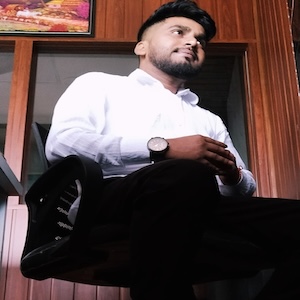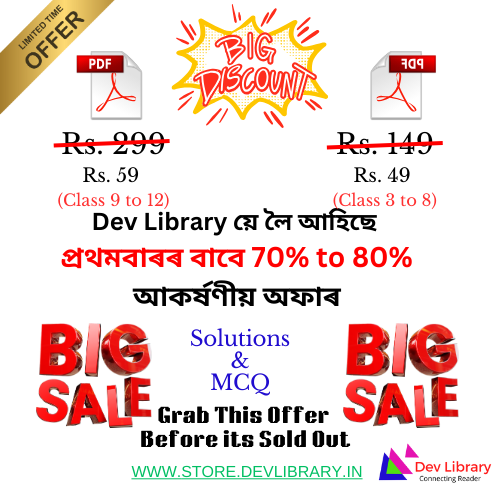SEBA Class 10 Weaving and Textile Design Chapter 1 Traditional Designs Solutions English Medium, SEBA Class 10 Weaving and Textile Design Question Answer, SEBA Class 10 Weaving and Textile Design Chapter 1 Traditional Designs Question Answer to each chapter is provided in the list so that you can easily browse throughout different chapter SEBA Class 10 Weaving and Textile Design Chapter 1 Traditional Designs English Medium Solutions and select needs one.
SEBA Class 10 Weaving and Textile Design Chapter 1 Traditional Designs
Also, you can read the SCERT book online in these sections Solutions by Expert Teachers as per SCERT (CBSE) Book guidelines. SEBA Weaving and Textile Design Elective Class 10 Question Answer. These solutions are part of SCERT All Subject Solutions. Here we have given SEBA Class 10 Weaving and Textile Design Chapter 1 Traditional Designs Solutions for All Chapter, You can practice these here.
Traditional Designs
Chapter – 1
| Self-Check Questions – 1 |
1. Name the traditional designs with their place or state.
Ans: The traditional designs with their place or state are listed below:
| Place | Traditional Textile Design |
| Andhra Pradesh | Kalamkari, Lambadi embroidery |
| Bihar | Madhubani, Sujani |
| Gujarat | Bandhani |
| Karnataka | Kasuti |
| Himachal Pradesh | Chamba Rumal |
| Kashmir | Carpets |
| Madhya Pradesh | Chanderi |
| Orissa | Ikat, Pipli appliqué |
| Rajasthan | Kota Doria, Bagru Prints, Bandhani |
| Telangana | Pochampalli |
| Uttar Pradesh | Phool Patti ka Kaam |
| West Bengal | Kantha, Jamdadi, Baluchari |
2. List the elements of design.
Ans: The elements of design are the basic components used by artists and designers to create visual compositions.
Here are the main elements of design:
(i) Line: In drawing, a line is the stroke of the pen or pencil but in graphic design, it’s any two connecting points. A line can be used for creating different optical illusions.
Various line directions are: Vertical lines- stress height and suggest power and strength. Horizontal lines—stress width and are peaceful and calm, provide a sense of stability. Diagonal line—dynamically energetic, causing more eye movement. Curved line— suggest motion, but are softer, more comforting. Eye moves quickly through design.
(ii) Shape: Shape is flat space closed by a line or colour. The shape or configuration of an individual describes the outer dimension or contour of an object and they are often used to emphasize a portion of an area.
(iii) Form: Form is the three dimensional version of a shape. The overall, three-dimensional, geometric shape or configuration of a floral composition.
(iv) Space: The area in, around, and between the components of the design, defined by the three-dimensional area occupied by the composition. It may be Positive space or Negative space.
(v) Texture: The surface quality of a material, as perceived by sight or touch. Eg. Smooth, coarse, waxy, rough, delicate, velvety.
(vi) Colour: Light reflected off an object; also referred to as hue.
(vii) Scale (Size): Amount of space a component occupies in a composition.
3. Name the two types of textile design.
Ans: The two types of textile design are:
(i) Floral Design: Floral design or flower arrangement is the art of using plant materials and flowers to create a pleasing and balanced composition. Floral motifs are more common in women’s clothes and furnishing materials. Professionally designed floral designs, arrangements or artwork incorporate the elements of floral design: line, form, space, texture, and colour, and the principles of floral design: balance, proportion, rhythm, contrast, harmony, and unity.
(ii) Geometrical Design: Geometric designs are the pattern based on basic geometric shapes like, circle, rectangle, triangle, oval, square etc. These basic shapes can form the pattern in individual or combination of two or more. It is easier to construct patterns or motifs by geometric shapes. However, by manipulating the basic shapes and straight / curve lines many attractive motifs can be constructed.
4. Draw the following design in plain paper-
(i) Geometrical.
Ans:
(ii) Floral.
Ans:
(iii) Abstract.
Ans:
(iv) Naturalistic.
Ans:
5. State the art features of Kolam floor decoration.
Ans: The art features of Kolam floor decoration are:
(i) Kolam, like other floor decorative arts of India, is a symbol of fortune. It is a form of drawing for decorating courtyards and pooja rooms/prayer halls in South India drawn mainly by women and young girls.
(ii) In many parts of India this religious culture is commonly known as Rangoli, Alpona, Sanjhi etc.The traditional medium used to draw is rice flour, chalk powder or rock powder, or synthetically colored powders.
(iii) This Kolam ritual is mostly used in Sri Lanka, the Indian states of Tamil Nadu, Karnataka, Telangana, Andhra Pradesh, Kerala and some parts of Goa, Maharashtra. These designs are basically in floral and geometrical format and with very bright colours like Red, Orange, Blue, Yellow and Pink.
6. Write any two differences between the “Phulkari” and “Kantha” embroidery technique.
Ans: The two differences between the “Phulkari” and “Kantha” embroidery technique are:
| Phulkari | Kantha |
| Phulkari is a traditional hand embroidery technique from Punjab, India and Pakistan. | Kantha is a traditional folk embroidery of Bengal, made by stitching together old saris and dhotis. |
| It uses bright color combinations and is mostly seen in floral patterns on traditional attire. | It uses a simple running stitch, often along the edges, and is usually done with soft, old fabrics. |
7. Which type of yarn is used for designing (stitching) phulkari design.
Ans: The darning stitch is the basic unit of Phulkari and the quality of a piece of both Bagh and Phulkari are graded according to its length and density of stitches. The narrowest is the stitch, the finest is the piece.
In order to create an unusual design or to border the khaddar, some other stitches like the herringbone stitch, running stitch, Holbeinstitch for buttonhole stitch were occasionally used. To fill in the motif either satin stitch or a variation known as stop stitch was preferred.
As for the type of yarn used in Phulkari, traditionally silk threads are preferred for their shine and richness. Cotton yarn may also be used for a more subtle, matte effect.
8. Draw a Arnai Design on plain paper.
Ans:
9. Match the following:
| (a) Paithani | (i) West Bengal |
| (b) Kantha | (ii) Rajasthan |
| (c) Chikankari | (iii) Maharashtra |
| (d) Bandhani | (iv) Uttar Pradesh |
Ans:
| (a) Paithani | (iii) Maharashtra |
| (b) Kantha | (i) West Bengal |
| (c) Chikankari | (iv) Uttar Pradesh |
| (d) Bandhani | (ii) Rajasthan |
10. Draw the motifs based on –
(i) Floral, (ii) Geometric, (iii) Abstract.
Ans:

Hi! my Name is Parimal Roy. I have completed my Bachelor’s degree in Philosophy (B.A.) from Silapathar General College. Currently, I am working as an HR Manager at Dev Library. It is a website that provides study materials for students from Class 3 to 12, including SCERT and NCERT notes. It also offers resources for BA, B.Com, B.Sc, and Computer Science, along with postgraduate notes. Besides study materials, the website has novels, eBooks, health and finance articles, biographies, quotes, and more.



